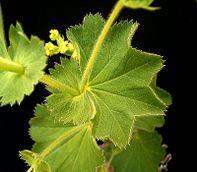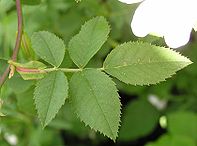277:
161:
237:
133:
206:
186:
257:
88:
108:
306:
The position of stipules on a plant varies widely from species to species, though they are often located near the base of a leaf. Stipules are most common on dicotyledons, where they appear in pairs alongside each leaf. Some monocotyledon plants display stipule-like structures, but only display one
374:
A stipule is "interpetiolar" if it is located in between the petioles, as opposed to being attached to the petioles, and generally one stipule from each leaf is fused together, so it appears that there's just one stipule between each leaf.
357:, deciduous and persistent. Caducous stipules fall off before the leaf unfolds, while deciduous stipules fall off immediately after the leaf unfolds. Persistent stipules remain attached to the plant.
407:
It is known that foliaceous stipules are used like leaves to make energy for the plants. Sometimes stipules protect the next leaf or bud as it grows in then falls off after the leaf unfolds, as with
661:
604:
378:
A stipule is "intrapetiolar" if it is located in the angle that's between a stem and a petiole. In this case, the two stipules generally form together and appear to be one stipule.
387:
A stipule is considered a "bud scale" if it is hard or scaly and protects leaf buds as they form. These generally fall off as soon as the leaf unfolds.
524:
396:
A stipule is considered to be "abaxial", "counter" or "leaf opposed" if it's located on the opposite side to where the leaf meets the stem.
276:
596:
365:
Stipules can be considered free lateral, adnate, interpetiolar, intrapetiolar, ochreate, foliaceous, bud scales, tendrillar or spiny.
580:
518:
451:
411:. Stipules can be used as climbing tendrils by climbing plants. Spiny stipules can be used to help protect the plant from animals.
56:. (In some older botanical writing, the term "stipule" was used more generally to refer to any small leaves or leaf-parts, notably
307:
per leaf. A relationship exists between the anatomy of the stem node and the presence or absence of stipules: most plants with
390:
A stipule is considered "tendrillar" if they are long thin tendrils, and are generally used by climbing plants.
50:, although in many species they may be inconspicuous —or sometimes entirely absent, and the leaf is then termed
676:
381:
A stipule is "ochreate" if a single stipule appears to be a solid tube that goes all the way around the stem.
651:
Esau, K. 1953. Plant
Anatomy. Second Edition. John Wiley & Sons, Inc., New York, London, Sidney. 767 pp.
408:
371:
A stipule is "adnate" if it's fused together on part of the petiole length, but the anterior is still free.
570:
508:
246:
160:
38:
is an outgrowth typically borne on both sides (sometimes on just one side) of the base of a leafstalk (the
266:
97:
433:. Vol. Part 2 Special organography. Translated by I.B. Balfour. New York: Hofner publishing company.
393:
A stipule is considered "spiny" if they are long and pointy. These are generally used to deter animals.
195:
465:"Investigations on the phylogeny of the angiosperms. 3. Nodal anatomy and the morphology of stipules"
354:
552:
484:
576:
514:
447:
218:
142:
476:
404:
Stipules have various functions. Some stipules are not well understood or may be vestigial.
121:
39:
384:
A stipule is "foliaceous" if it is leaf-like. These are generally used to photosynthesize.
236:
286:
47:
546:
330:
322:
132:
670:
428:
311:
65:
205:
185:
464:
632:
368:
A stipule can be fused to the stem, or to the other stipule from the same node.
256:
174:
87:
107:
326:
116:
57:
628:
A Manual of Botany: Anatomical and
Physiological for the Use of Students
626:
336:
If a single stipule goes all the way around the stem, it is known as an
17:
488:
430:
Organography of plants, especially of the
Archegoniatae and Spermaphyta
337:
31:
480:
275:
255:
235:
204:
184:
159:
131:
106:
86:
69:
169:
43:
510:
Plant Form: An
Illustrated Guide to Flowering Plant Morphology
290:. The white "stipule" contains a new leaf and a new "stipule".
321:
Stipules are morphologically variable and might appear as
42:). Stipules are considered part of the anatomy of the
353:
The three types of stipules according to duration are
601:
PublishYourArticles.net - Publish Your
Articles Now
597:"What are Stipules and what are its types ?"
8:
569:Wyk, Braam Van; Wyk, Piet Van (2007-01-01).
557:Caducous, Deciduous and Persistent stipules.
264:Stipular spines accompanied by prickles of
463:Sinnott, E. W. & I. W. Bailey (1914).
140:Fused together and leaf-like stipules of
572:How to Identify Trees in Southern Africa
551:. A.S. Barnes & H.L. Burr. pp.
419:
27:Appendage of a leaf in flowering plants
361:According to shape, size and position
333:, or laminar (leaf-like) structures.
193:Stipules building glandular hairs on
7:
502:
500:
498:
213:Stipules protecting young leaves of
25:
513:. Timber Press. pp. 74–79.
168:Leafy stipules at the base of a
607:from the original on 2021-03-02
527:from the original on 2023-04-14
446:Wordsworth Editions Ltd. 1994,
507:Bell, Adrian D. (2008-01-01).
1:
548:Botany of the Southern States
625:Brown, Robert (1874-01-01).
314:have stipules; species with
244:Stipular spine clusters of
693:
575:. Struik. pp. 33–36.
545:Darby, John (1860-01-01).
469:American Journal of Botany
444:Concise English Dictionary
427:Goebel, K.E.v. (1969) .
302:General characteristics
115:Stipular spines on the
631:. Blackwood. pp.
292:
271:
267:Euphorbia didiereoides
251:
223:
200:
180:
147:
127:
102:
349:According to duration
318:nodes lack stipules.
279:
259:
247:Euphorbia spectabilis
239:
208:
188:
163:
135:
110:
95:Glandular stipule of
90:
662:Stipules and stipels
98:Euphorbia pteroneura
400:Purpose of stipules
646:General references
293:
272:
252:
224:
201:
181:
148:
128:
103:
299:
298:
230:
229:
219:European Hornbeam
154:
153:
143:Alchemilla mollis
79:Types of stipules
16:(Redirected from
684:
640:
639:
622:
616:
615:
613:
612:
593:
587:
586:
566:
560:
559:
542:
536:
535:
533:
532:
504:
493:
492:
460:
454:
441:
435:
434:
424:
291:
270:
250:
232:
231:
222:
215:Carpinus betulus
199:
196:Jatropha spicata
179:
156:
155:
146:
126:
122:Prosopis pallida
101:
83:
82:
75:, straw, stalk.
21:
692:
691:
687:
686:
685:
683:
682:
681:
677:Leaf morphology
667:
666:
658:
648:
643:
624:
623:
619:
610:
608:
595:
594:
590:
583:
568:
567:
563:
544:
543:
539:
530:
528:
521:
506:
505:
496:
481:10.2307/2435043
462:
461:
457:
442:
438:
426:
425:
421:
417:
402:
363:
351:
346:
304:
287:Ficus religiosa
284:The stipule of
283:
282:
280:
263:
262:
260:
243:
242:
240:
212:
211:
209:
192:
191:
189:
167:
166:
164:
139:
138:
136:
114:
113:
111:
94:
93:
91:
81:
48:flowering plant
28:
23:
22:
15:
12:
11:
5:
690:
688:
680:
679:
669:
668:
665:
664:
657:
656:External links
654:
653:
652:
647:
644:
642:
641:
617:
603:. 2012-02-14.
588:
581:
561:
537:
519:
494:
475:(9): 441–453.
455:
436:
418:
416:
413:
401:
398:
362:
359:
350:
347:
345:
342:
303:
300:
297:
296:
294:
273:
253:
228:
227:
225:
202:
182:
152:
151:
149:
129:
104:
80:
77:
64:was coined by
26:
24:
14:
13:
10:
9:
6:
4:
3:
2:
689:
678:
675:
674:
672:
663:
660:
659:
655:
650:
649:
645:
638:
634:
630:
629:
621:
618:
606:
602:
598:
592:
589:
584:
582:9781770072404
578:
574:
573:
565:
562:
558:
554:
550:
549:
541:
538:
526:
522:
520:9780881928501
516:
512:
511:
503:
501:
499:
495:
490:
486:
482:
478:
474:
470:
466:
459:
456:
453:
452:1-85326-328-1
449:
445:
440:
437:
432:
431:
423:
420:
414:
412:
410:
409:Tulip Poplars
405:
399:
397:
394:
391:
388:
385:
382:
379:
376:
372:
369:
366:
360:
358:
356:
348:
343:
341:
339:
334:
332:
328:
324:
319:
317:
313:
310:
301:
295:
289:
288:
278:
274:
269:
268:
258:
254:
249:
248:
238:
234:
233:
226:
220:
216:
207:
203:
198:
197:
187:
183:
177:
176:
171:
162:
158:
157:
150:
145:
144:
134:
130:
124:
123:
118:
109:
105:
100:
99:
89:
85:
84:
78:
76:
74:
71:
67:
63:
60:.) The word
59:
55:
54:
49:
46:of a typical
45:
41:
37:
33:
19:
636:
627:
620:
609:. Retrieved
600:
591:
571:
564:
556:
547:
540:
529:. Retrieved
509:
472:
468:
458:
443:
439:
429:
422:
406:
403:
395:
392:
389:
386:
383:
380:
377:
373:
370:
367:
364:
352:
335:
320:
315:
308:
305:
285:
265:
245:
214:
194:
173:
141:
120:
96:
72:
61:
52:
51:
35:
29:
175:Rosa canina
53:exstipulate
611:2017-04-04
531:2020-10-20
415:References
325:, scales,
316:unilacunar
309:trilacunar
58:prophylls
671:Category
637:stipule.
605:Archived
525:Archived
355:caducous
117:mesquite
66:Linnaeus
18:Stipules
489:2435043
73:stipula
62:stipule
40:petiole
36:stipule
635:-152.
579:
517:
487:
450:
338:ochrea
331:spines
323:glands
281:
261:
241:
210:
190:
172:leaf (
165:
137:
119:tree (
112:
92:
32:botany
555:-61.
485:JSTOR
344:Types
327:hairs
312:nodes
70:Latin
68:from
577:ISBN
515:ISBN
448:ISBN
170:Rose
44:leaf
34:, a
633:149
477:doi
30:In
673::
599:.
553:59
523:.
497:^
483:.
471:.
467:.
340:.
329:,
614:.
585:.
534:.
491:.
479::
473:1
221:)
217:(
178:)
125:)
20:)
Text is available under the Creative Commons Attribution-ShareAlike License. Additional terms may apply.








